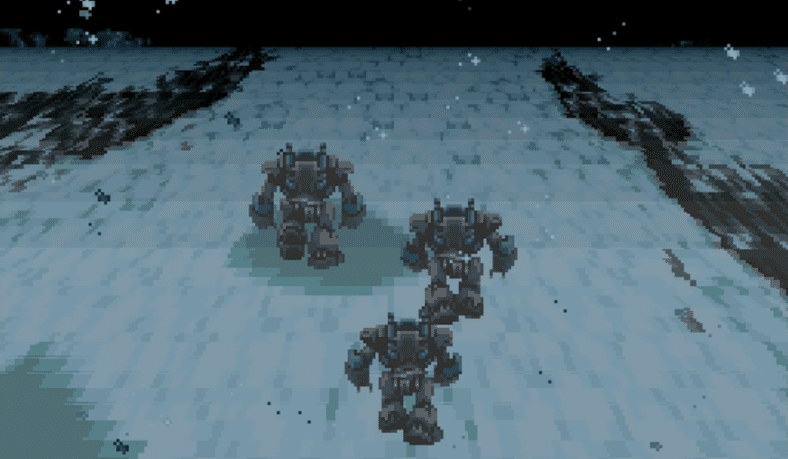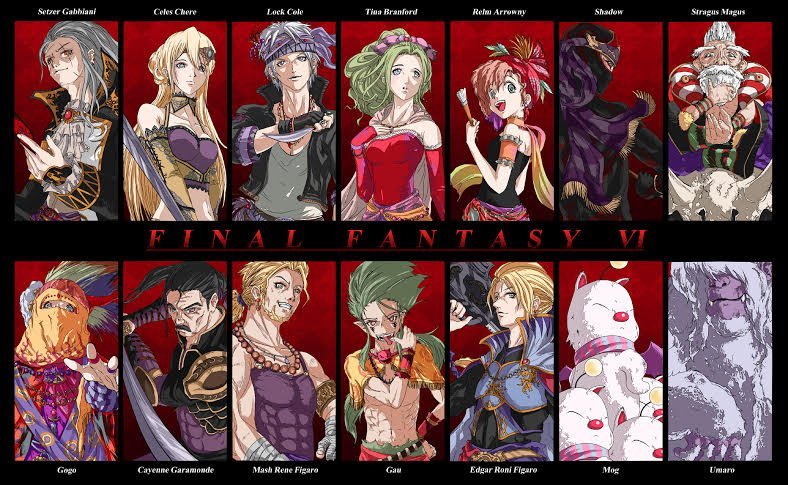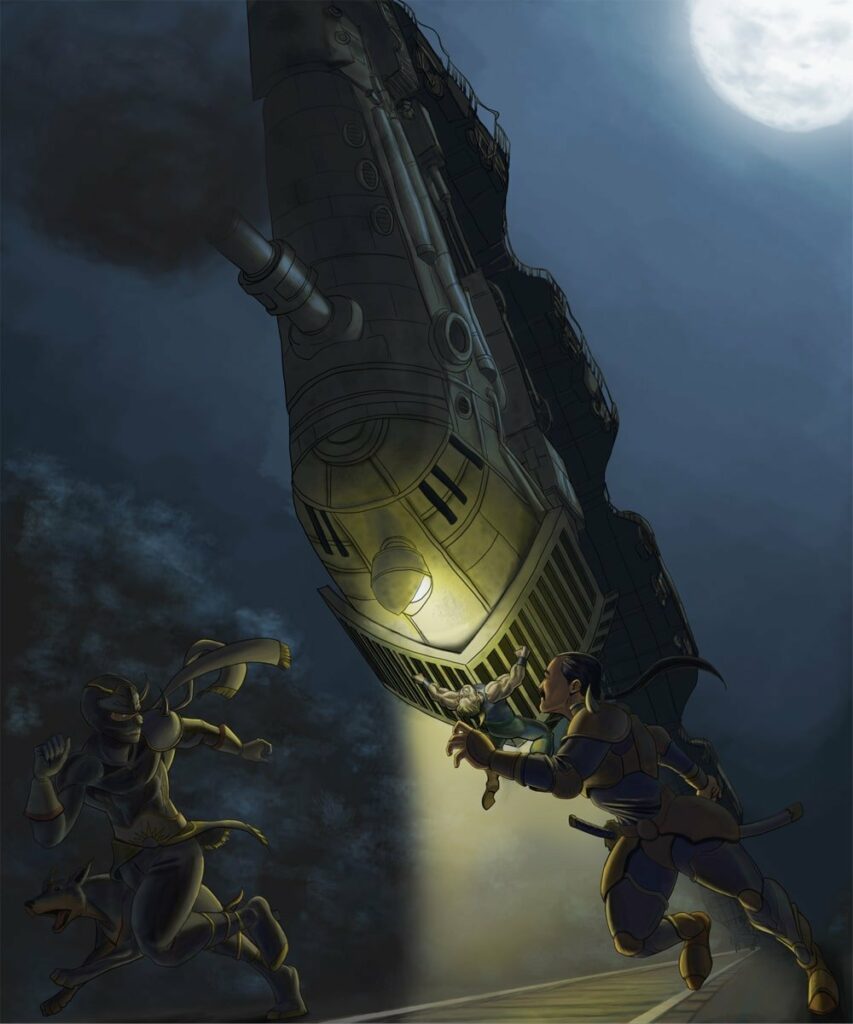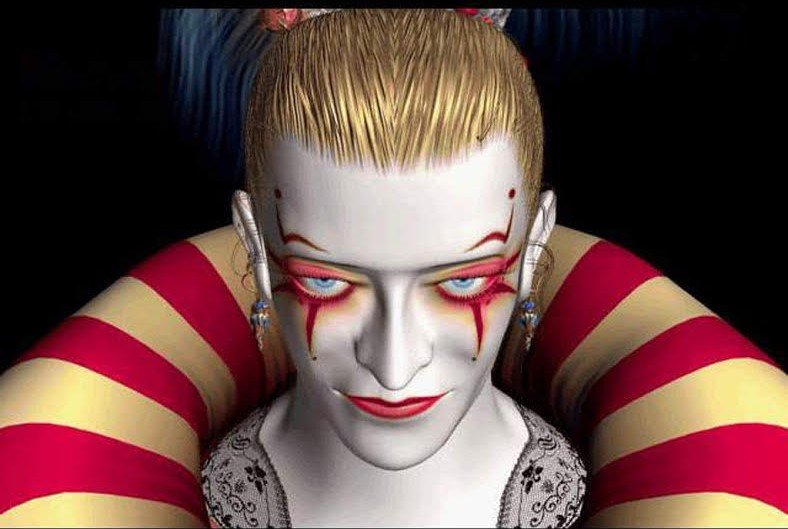 We have come to the end of the SNES era of the Final Fantasy franchise, and what an ending it is! Final Fantasy VI is arguably one of the greatest entries in the series. From the epic opera-inspired story line, to unforgettable villains, this is simply one of the greatest
We have come to the end of the SNES era of the Final Fantasy franchise, and what an ending it is! Final Fantasy VI is arguably one of the greatest entries in the series. From the epic opera-inspired story line, to unforgettable villains, this is simply one of the greatest
Bringing the New: Background
Final Fantasy VI is the
Our story opens with a scrolling narrative about Great War of the Magi 1000 years before the game takes place. The Warring Triad, three gods, initiated the war and the catastrophic consequences. Their release of magical energy created magical warriors called espers. In the horrid aftermath, the Triad gave free will to the espers. Their only request was that the gods be sealed in stone and locked away. The espers obliged, hiding away the stone gods and faded away to myth and legend. But the world has changed – and now technological advancements and a cruel Empire have led to the discovery of the esper’s safe haven.
The Thick of the Plot
The game picks up with the mysterious magic wielding Terra accompanied by two soldiers (Vicks and Wedge) on a mission for the Empire. They have been sent to investigate a frozen esper in the town of Narshe. When they reach the icy creature, it reacts with Terra and she breaks free of the Empire's control. Unfortunately, she wakes with amnesia and an angry mob crying for her capture.
With the help of Locke, a treasure hunter, Terra is protected from the Evil Empire and brought before the leader of a resistance group called ‘The Returners.’ Both the Empire and the Returns are interested in Terra’s natural ability to use magic; she is the key to victory and understanding the power of the legendary espers.
The Returners must convince Terra to join with them in order to topple the evil Empire – ruled by Emperor Gestahl and his three deadly generals. But not everything is as it seems. Will our heroes succeed, or will this feud cause the gods to awaken for another War of the Magi?
A Bigger Picture and Avoiding Spoilers
 A simple synopsis doesn’t do this game justice. It is difficult to go into the winding details of Final Fantasy VI without spoiling the wonderful discoveries in the plot. The story is simple enough: an evil empire is taking over the world, and the Returners are trying to stop it. It is a very familiar story, but what makes it extraordinary is the character development. With fourteen different characters, it would seem that the story would get murky with unnecessary backstory, but it does not.
A simple synopsis doesn’t do this game justice. It is difficult to go into the winding details of Final Fantasy VI without spoiling the wonderful discoveries in the plot. The story is simple enough: an evil empire is taking over the world, and the Returners are trying to stop it. It is a very familiar story, but what makes it extraordinary is the character development. With fourteen different characters, it would seem that the story would get murky with unnecessary backstory, but it does not.
Up to this point, the Final Fantasy series had one or two entries with well-developed characters, more notably Final Fantasy IV and V. Final Fantasy VI took character development to a whole new level. Gamers would be hard-pressed to pick out the main protagonist because each of the fourteen characters is a main protagonist. Each character has his or her backstory, clear motivation, and an amazing character theme. A mysterious woman, a heart-broken treasure hunter, a loyal knight, and a wild boy are just a handful of the wonderful cast, and their stories weave an incredible
tale.
Final Fantasy IV and V each took turns expanding video game narratives, but Final Fantasy VI really lets these characters grow. Their stories intertwine and their growth delivers a rich experience. While the characters are some of my favorite in the series, this game also contains one of the franchise’s greatest antagonists.
Final Fantasy toys with Joker-esque style chaos in its main villain,
The Last Laugh
There is very little to complain about with a story this massive. The game moves along at a steady pace and has some unpredictable twists. However, at one point in the game, the main narrative drops off and while Kefka remains a looming threat, it is with less urgency. That’s not to say that the second half of the game lacks a narrative – it depends on how many side-quests a player wants to complete. This open exploration really changes the pace of the game, and slows things down. Also, depending on which version you decide to pick up, a little theatrical emphasis is lost in translation.

Music: Dancing Mad
One of Final Fantasy VI’s defining features is its impressive soundtrack. While the previous entries were amazing in their own right, this particular symphony takes the cake. Nobuo Uematsu enriched the narrative of this RPG, elevating it to a whole new level. From the opening scene to the epic end, the music itself tells a story through carefully crafted themes and memorable movements. One of Final Fantasy VI’s most captivating scenes involves a
Game Play: Active Time Battle
 Final Fantasy VI’s play style is very similar to the previous entries. Players must traverse a world map, towns, and dungeons in an effort to gain levels, learn new information, and discover hidden treasures. An interesting addition is the option of the Colosseum. Players have the option to bet items in their inventory for some rare and powerful weapons, provided their character can defeat the appointed enemy.
Final Fantasy VI’s play style is very similar to the previous entries. Players must traverse a world map, towns, and dungeons in an effort to gain levels, learn new information, and discover hidden treasures. An interesting addition is the option of the Colosseum. Players have the option to bet items in their inventory for some rare and powerful weapons, provided their character can defeat the appointed enemy.
Final Fantasy VI is also the first game in the series to split parties up. The players are given enough characters to actually take on sprawling dungeons with two to three separate parties. This particular addition received mixed reviews – especially if players didn’t like swapping equipment between the parties. While both of these additions pull away from the original series formula, they were not a complete departure and gave new life to the series.
It’s also worth mentioning that this is the first game in the franchise that doesn’t require a specific party lead. For example: Final Fantasy IV required players to have specific members in the party at all times. With Final Fantasy VI, there are a few instances where certain characters are forced into your party, but for most of the game players can customize their party.
Combat: Limit breaks and ATB
Final Fantasy VI’s combat system is formulated after the ATB system from the previous two entries. Like Final Fantasy V, players can see the ATB bar fill up and anticipate their next move. This game also embraces Final Fantasy IV’s job class system; each character is given a specific job class with special abilities that cannot be transferred. The special abilities are unique interpretations of the job classes veterans have come to know, but with a new twist.
Also new to the series is the ‘Limit Break’ or the desperation attack. If characters are low on hit points, it is more likely that they will deliver a ‘critical’ hit. This concept has since been expanded upon, but Final Fantasy VI is the first to do it.
Relics and Espers
While previous entries had characters suiting up in full armor, Final Fantasy VI simplified the process slightly. In this entry, it is possible to equip each character with a weapon, a shield, armor, and a helmet. These items raise a character’s stats and some have party member limitations. Players can also equip two relics that bestow special immunities, stat boosts, or various other helpful abilities.
In addition to basic equipment, players can equip characters with espers in order to learn magic. Each esper, or ‘magicite’ contains a specific number of spells, stat growth, and spell learn rate. For example: The esper ‘Phantom’ contains the spells berserk, vanish, and gravity. Two spells are learned x3 rate, while one is x5. At level up, the character gains an added MP growth of 10%. In battle, players receive magic points which are then applied to the spell rate. After the spell percentage reaches 100%, that character learns the spell.
Any character can equip espers; this leads to endless character customization. Depending on which espers a player decides to equip, each play through will contain very different characters.
The Downside
 While endless customization of magic seems like a wonderful idea, it can throw off the balance of the party. Players can grind to teach all of their characters magic, which takes away the fun. Magic power, however depends on your characters stats. That means a character like Shadow (a ninja) will cast weaker spells than a character with higher a magic stat, like Terra. This helps a bit, but the esper stat bonuses can easily override that.
While endless customization of magic seems like a wonderful idea, it can throw off the balance of the party. Players can grind to teach all of their characters magic, which takes away the fun. Magic power, however depends on your characters stats. That means a character like Shadow (a ninja) will cast weaker spells than a character with higher a magic stat, like Terra. This helps a bit, but the esper stat bonuses can easily override that.
Also, the run system in this game is horrible. Characters run away one at a time – and it takes them a long time to do so. This game has an extremely high encounter rate and running from battles can often result an entire party death. I guess the solution is to not run from battles or find a Safety Bit.
Another criticism revolves around the character Gau and his abilities. Gau’s skills are based on learning monsters’ abilities, which he gains by leaping on them. He can only do this in an area called ‘The Veldt.’ The Veldt contains all the monsters a player has encountered during a run-through, and it runs on a particular algorithm. It is difficult to gather every single ‘rage’ in the game without a ton of grinding.
Final Thoughts
Final Fantasy VI is an amazing final bow for the SNES era of the franchise. With wonderful characters, an enchanting soundtrack, and excellent game play, this is simply one of the best games in the series.




Recommended Comments
There are no comments to display.